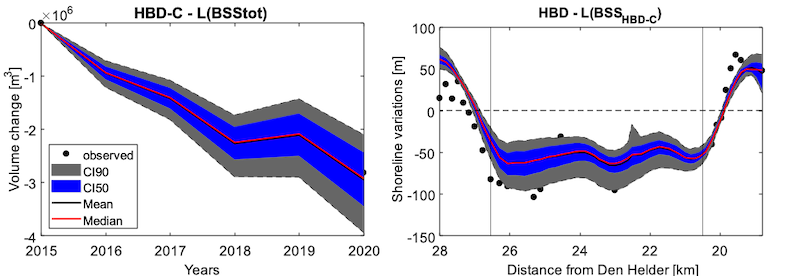A. Kroon1,2*, P. Petrova3, Y. Attema1, B.G. Ruessink3, B.J.A. Huisman4, M.A. de Schipper2,
1 Svašek Hydraulics; 2 Delft University of Technology; 3 Utrecht University; 4 Deltares
*corresponding author:
Introduction
Parameter uncertainty can be an important contribution to uncertainty in the predictions of morphological models on an engineering time scale (~2-20y). This uncertainty is rarely assessed in practical model applications in the coastal zone because existing morphological models are computationally demanding. However, a single deterministic prediction does not provide an uncertainty range originating from parameter uncertainty. The one-line model ShorelineS is now being upgraded to the level of a verified engineering software tool as part of a joint industry TKI project led by Deltares and IHE-Delft. The efficiency of this model creates the opportunity to assess the parameter uncertainty in coastal zone applications by doing many computations.
Methods
To assess the parameter uncertainty, the development of the Hondsbossche Dunes nourishment is modelled for the first five years after placement. Over 7000 simulations with different parameter settings have been analysed using the probabilistic GLUE method. Within this method, an uncertainty bandwidth conditioned on observations is established. A total of five model parameters have been varied within reasonable ranges: (1) the median grain size, D50; (2) the breaker index, γ; (3) the scaling factor in the longshore sediment transport formulae, qscale; (4) the offshore depth of the applied wave boundary conditions, ddeep, and (5) the active profile height, d. Moreover, four different longshore sediment transport (LST) formulae are used in the model simulations.
Results
Results show that the model can be calibrated to accurately predict (the temporal variation in) the volume change over the central part of the nourishment (Figure 1a). Two parameters are identified that influence the model predictions significantly: the sediment transport scaling factor, qscale, and the active profile height, d, with especially qscale strongly dependent on the LST formula. In addition, the model skill increases when the wave boundary is applied at a larger depth (ddeep), enabling the foreshore to rotate with the shoreline change. The observed variation in the shoreline position is well enclosed by the predicted uncertainty bandwidth (Figure 1b). In more detail, the model is not able to reproduce the strong alongshore variations in the observed shoreline retreat.

Figure 1: Temporal volume changes over the central sector of the HBD since construction (a), and shoreline position change in the alongshore direction after 5 years (b). Central sector indicated by black vertical lines in panel b.
The results reveal the uncertainty in ShorelineS model applications and their origin. Parameter uncertainty can result in large variations in the forecasted values, with parameters and LST formulations showing a co dependence. The results show that a reasonable estimate of uncertainty can be obtained with only 200-500 simulations.
I. Surname1*, F.N. Another-Surname2 , Y. Next-Surname2
1 University Name, Country; 2 Organization Name, Country
* Corresponding author: mail.name@organization.org


